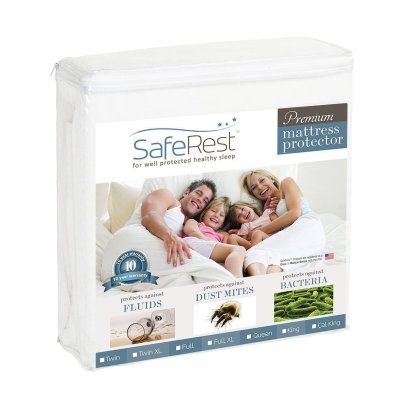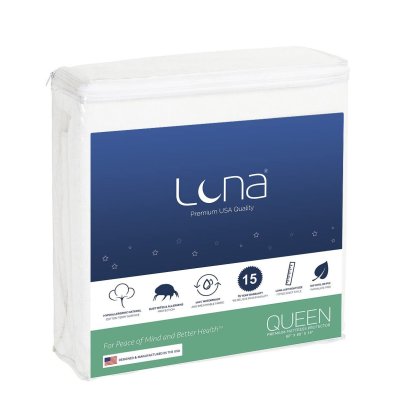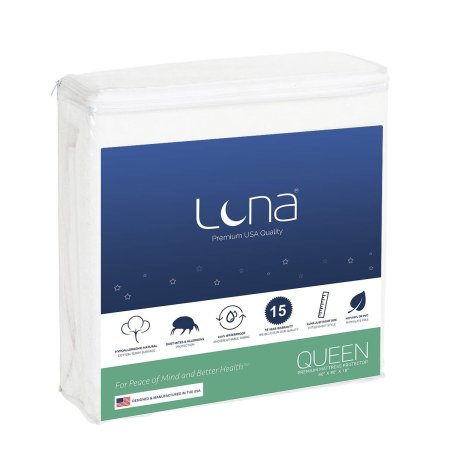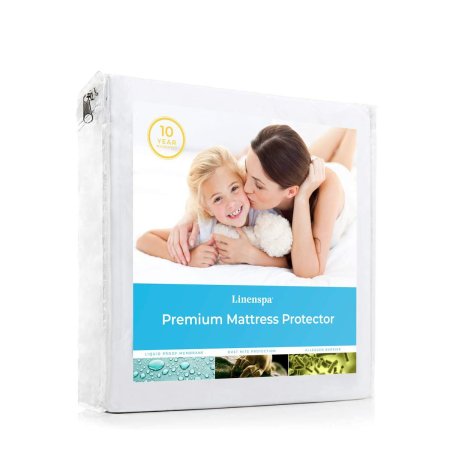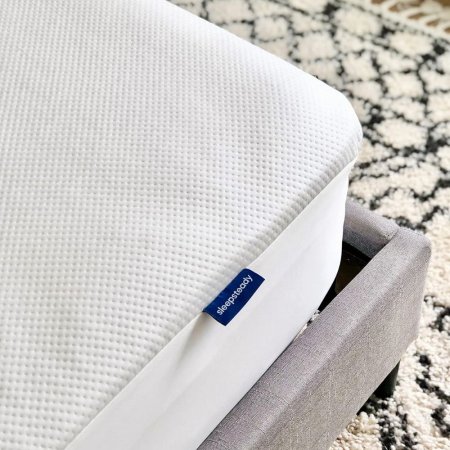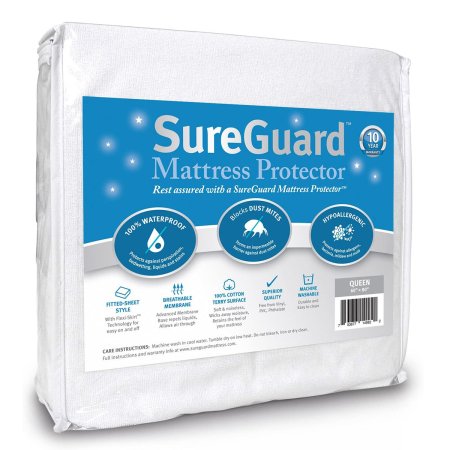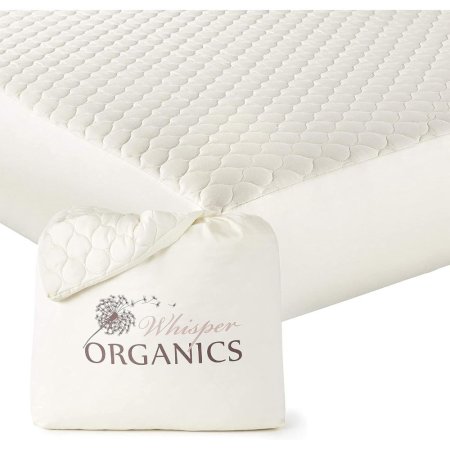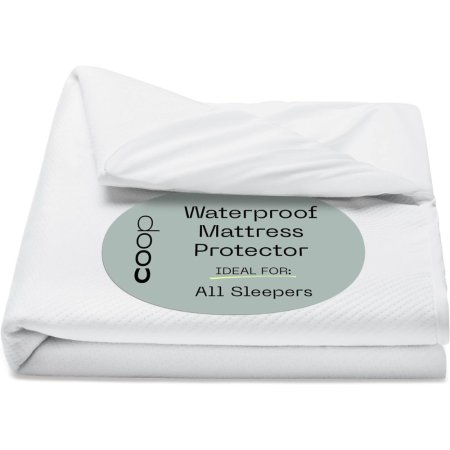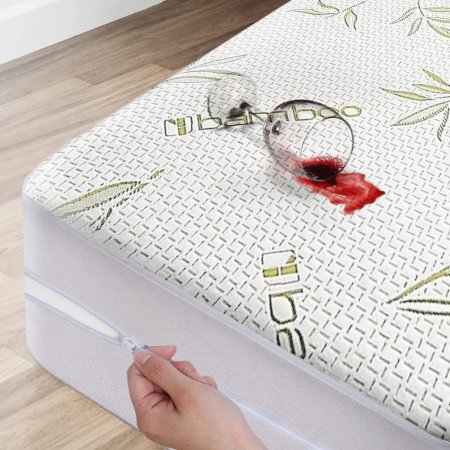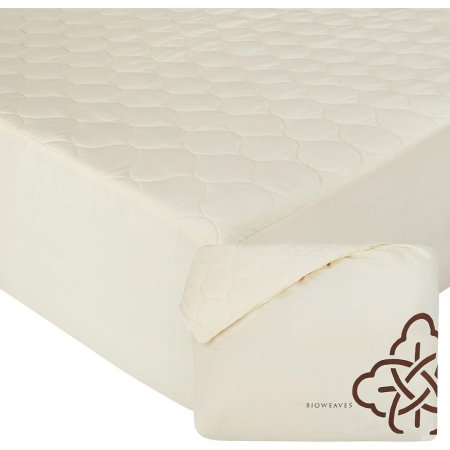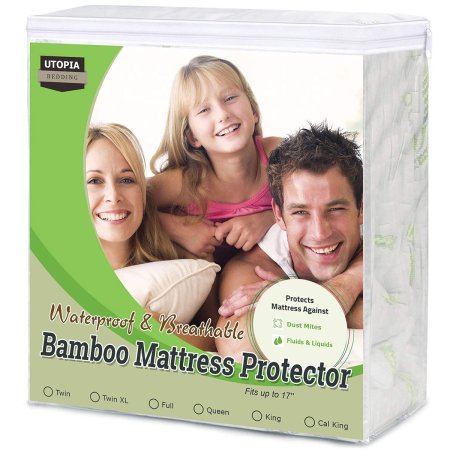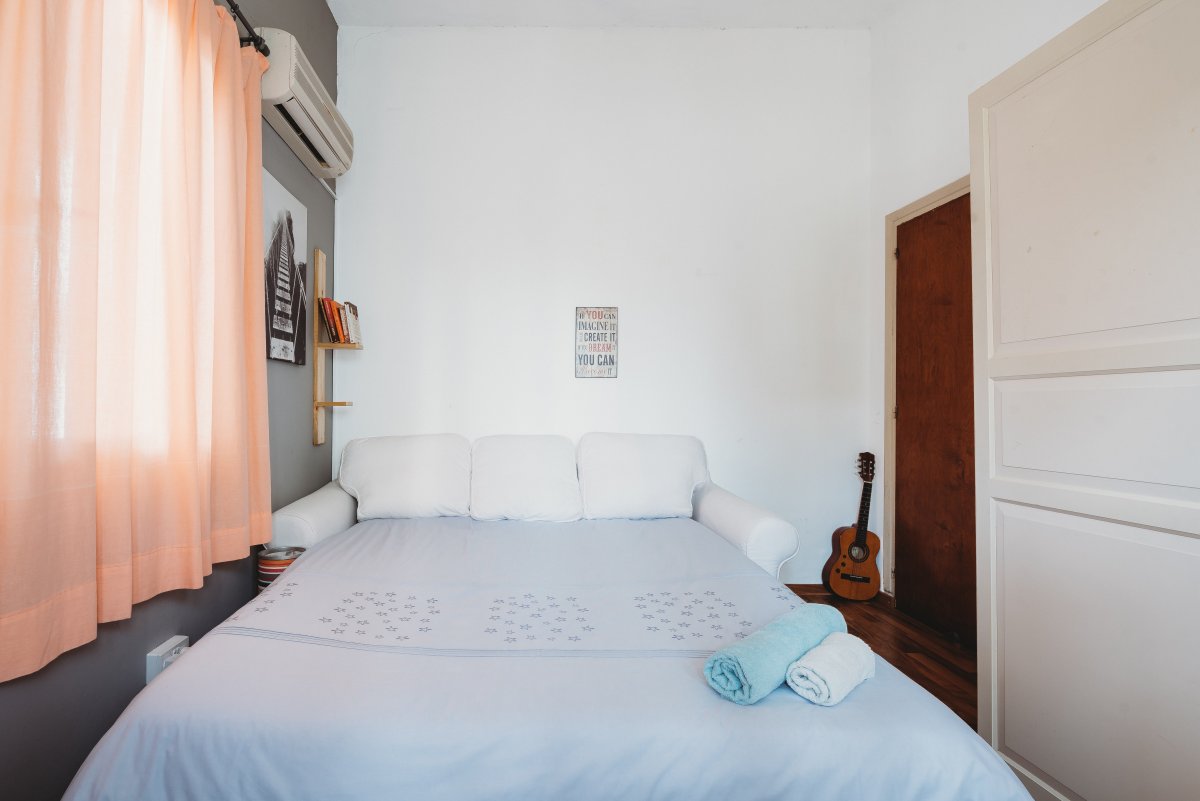
We may earn revenue from the products available on this page and participate in affiliate programs. Learn More ›
Mattresses are a major financial investment that can make sleep more comfortable, so you’ll want them to last for years. A mattress protector puts a defensive barrier between your body and the mattress to further the life of the mattress. Plus, protectors repel body fluids, liquids, dust, dust mites, allergens, and, in some cases, bed bugs.
The best mattress protectors are also easy to wash and dry. We compiled this list of top picks based on materials, sizes, and protective features.
- BEST OVERALL: SafeRest Premium Mattress Protector
- RUNNER-UP: Luna Premium Mattress Protector
- BEST BANG FOR THE BUCK: Linenspa Premium Smooth Mattress Protector
- UPGRADE PICK: Sleepsteady Luxury Tencel Mattress Protector
- BEST HYPOALLERGENIC: SureGuard Mattress Protector
- BEST ORGANIC: Whisper Organics Cotton Mattress Protector
- BEST WATERPROOF: Coop Home Goods Ultra-Luxe Mattress Protector
- BEST COOLING: Dreamfield Linen Store Bamboo Mattress Protector
- BEST COTTON: Bioweaves 100% Organic Cotton Mattress Pad Cover
- BEST BAMBOO: Utopia Bedding Bamboo Waterproof Mattress Protector
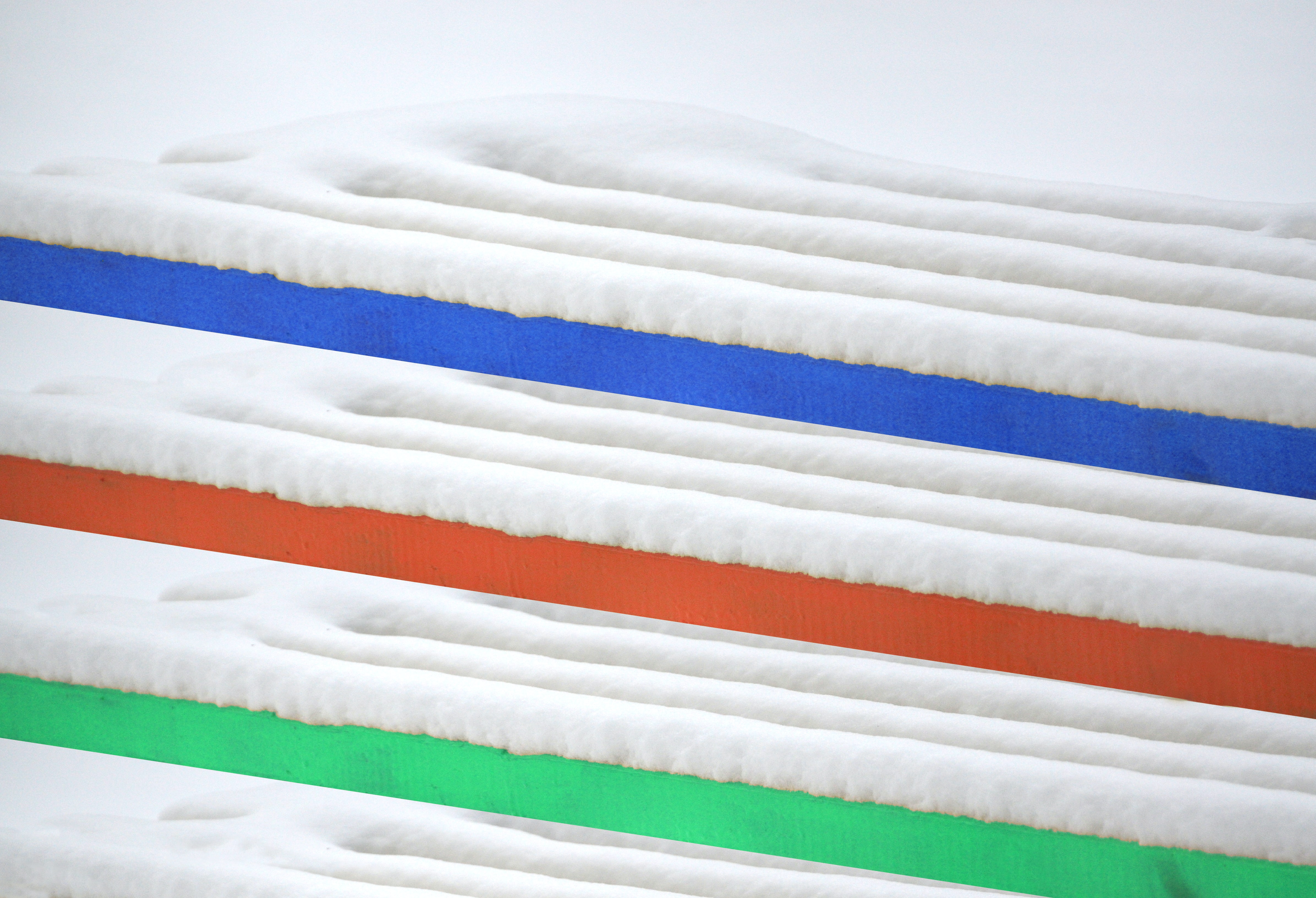
How We Chose the Best Mattress Protectors
At first glance, all mattress protectors look quite similar. However, after checking into products from more than 30 manufacturers, it soon became obvious that a host of variations among mattress protectors could affect shoppers’ buying decisions.
In putting together our top picks, we sought to offer as broad a range of options as possible. We looked at materials, whether the brand offered a full range of sizes, features like waterproofing or allergy barriers, and, of course, price. We also collated buyer feedback to get an idea of how the protectors performed in real-world use.
In addition, we gained valuable input from industry expert Byron Golub, vice president of Product & Merchandising at luxury mattress company Saatva. “A protector can prevent common accidents from damaging your mattress, ultimately extending its life, and saving you from the cost of a new one,” he says. Golub added a bonus feature for these products: “In some cases, a mattress protector can help prevent voiding your warranty.” He also says that “unlike cleaning a mattress, washing a mattress protector is much easier.”
Our Top Picks
The best mattress protectors have several, if not all, of the features and characteristics that truly protect a mattress. The models on this list successfully block dust, dirt, and other debris. Many of these models are also waterproof and hypoallergenic to further protect the mattress.
Best Overall
SafeRest Premium Mattress Protector
Pros
- High-quality breathable material protects against fluids, perspiration, allergens, and dust mites
- Snug deep-pocket design with flexible fit that won’t crinkle and cause discomfort
- Available in a comprehensive range of sizes, including one for cribs
Cons
- Problems are rare but a few buyers complained theirs were not entirely waterproof
Product Specs
- Material: Cotton terry
- Mattress depth: Up to 18 inches
- Sizes: Twin, twin XL, full, queen, king, California king, crib
The SafeRest Premium mattress protector ticks all the boxes when it comes to quality mattress protection. It has a hypoallergenic cotton terry top layer with a waterproof membrane backing that gives this protector breathability but prevents liquids from seeping into the mattress. Even though this model is waterproof, it isn’t noisy since it blends seamlessly with the mattress during movement.
This protector also is Oeko-Tex Standard 100 certified, which means the SafeRest was tested and found to be free of harmful substances like PVC and volatile organic compounds (VOCs). This makes it a safe choice for sleepers with allergies and chemical sensitivities. The SafeRest’s deep pocket fits mattresses up to 18 inches thick, which accommodates most modern mattresses. The machine-washable material tumbles dry safely on low heat.
Get the SafeRest mattress protector at Amazon, Walmart, or Target.
Runner-up
Luna Premium Mattress Protector
Pros
- A premium-quality model with full features at a competitive price
- Luna Airflow technology prevents moisture from seeping through but offers breathability
- Hypoallergenic cotton keeps out common irritants while Invisi-Lay flexibility retains original mattress comfort
Cons
- A small percentage of owners say the waterproof layer eventually delaminated or broke up
Product Specs
- Material: Cotton terry
- Mattress depth: Up to 18 inches
- Sizes: Twin, twin XL, full, full XL, queen, king, California king
The soft terry cloth top layer of this Luna Premium mattress protector cradles the body while it offers breathability and absorbency. It’s backed with Luna Airflow technology that allows air to circulate but prevents liquid seepage into the mattress. The cover also cuts down on heat buildup for a cooler night’s sleep.
The hypoallergenic cotton surface of this protector doesn’t make noise, so it’s less likely to wake light sleepers. Its design materials keep out common allergens like dust, dust mites, and pollen. Luna uses Invisi-Lay technology that keeps the protector flexible, so it doesn’t change the feel of the mattress.
Get the Luna mattress protector at Amazon, Walmart, or Target.
Best Bang For The Buck
Linenspa Premium Smooth Mattress Protector
Pros
- Includes many of the features offered by competitors but at a considerably lower cost
- Noiseless brushed polyester top fabric is breathable, and underlayer is waterproof
- Machine washable for easy cleaning and dryer-safe (on low heat)
Cons
- A few leaks have been reported by users
- Mattress depth is limited to 14 inches; too shallow for some mattresses
Product Specs
- Material: Polyester/polyurethane
- Mattress depth: Up to 14 inches
- Sizes: Twin, twin XL, full, full XL, queen, king, California king
Linenspa’s mattress protector has a liquid-proof membrane that lets air and heat pass through but keeps liquids on the surface. It effectively prevents body fluids such as sweat and urine from penetrating the mattress yet lets the body breathe to prevent overheating. Protection against dust mites and allergens is built into the design. This protector has an ultrathin fabric that doesn’t crinkle under movement, making it a quiet, hypoallergenic alternative for light sleepers.
Although the Linenspa mattress protector comes in a full range of mattress sizes, its depth is limited to 14 inches.
Get the Linenspa mattress protector at Amazon.
Upgrade Pick
Sleepsteady Luxury Tencel Mattress Protector
Pros
- Luxurious top layer is softer than cotton and more breathable than bamboo
- Manufacturer claims that polyester side skirt is 50 percent thicker than competitors to prevent tearing
- Less fussy to clean than some, with washing machine on warm and dryer on medium
Cons
- A few buyers said urine leaked through, and sizes are more limited compared to other options on our list
Product Specs
- Material: Tencel top/polyurethane bottom
- Mattress depth: Up to 18 inches
- Sizes: Twin, full, queen, king, California king
The quality of a mattress protector can often be felt through a bedsheet, and a common complaint with inexpensive options is that they crinkle and cause discomfort or noise. Quality cotton and bamboo models overcome most problems, but none have the luxury feel of natural Tencel fabric. In fact, Sleepsteady claims their luxury mattress protector is 10 times softer than cotton.
The material is more breathable and cooling than bamboo, thus
for those who sleep hot or are prone to night sweats. Underneath the Tencel layer is polyurethane to protect the mattress from spills. The polyester sides are thicker than usual, so tears when fitting or changing are less likely than with some protectors. The elasticated edge ensures a snug fit and prevents movement of the protector.
Get the Sleepsteady mattress protector at Amazon.
Best Hypoallergenic
SureGuard Mattress Protector
Pros
- Offers a hypoallergenic barrier against dust mites allergens, bacteria, mildew, and mold
- Breathable top layer absorbs moisture; ideal for those who suffer night sweats
- Waterproof underlayer allows body heat to flow through, keeping the mattress cool
Cons
- Premium-priced option and there are questions about claimed Greenguard Gold certification
Product Specs
- Material: Cotton terry
- Mattress depth: Up to 20 inches
- Sizes: Twin, twin XL, full, full XL, queen, king, California king, mini crib, crib
Dust mites feed on dead skin cells. The SureGuard mattress protector creates a barrier between the sleeper and dust mites and pollen that have made their way into the mattress. At the same time, it keeps allergens from permeating the mattress, and the hypoallergenic back acts as a barrier against water, bacteria, mildew, and mold.
Although the SureGuard provides excellent protection, it doesn’t change the feel of the mattress. The lightweight fabric moves with the mattress to cut down on noise and enhances breathability so the sleeper stays comfortable. SureGuard’s mattress protectors have been GreenGuard Gold certified in the past (free of substances like fire retardants and phthalates), but this may have expired. It also has Oeko-Tex Standard 100 certification.
Get the SureGuard mattress protector at Amazon or Walmart.
Best Organic
Whisper Organics Cotton Mattress Protector
Pros
- Environmentally friendly organic cotton meets the Global Organic Textiles Standard (GOTS)
- High thread count and thick cotton wadding offer a strong but soft sleeping surface
- Naturally dyed surface is breathable, skin-friendly, and contains no synthetic material
Cons
- Comes with a premium price tag and is not fully waterproof
Product Specs
- Material: Organic cotton
- Mattress depth: Up to 17 inches
- Sizes: Twin, twin XL, full, queen, king, California king
Organic mattress protectors should be nontoxic and contain no harmful chemicals so they’re safe for family members and for the environment. This luxury model from Whisper Organics meets those expectations, and complies with the standards set by the GOTS. It is 100 percent natural cotton with no synthetic fibers.
The high thread count material gives good wear resistance, and thick wadding provides high comfort while remaining breathable. The Whisper Organics mattress protector can be washed in warm water and tumbled dry at low heat, though the manufacturer warns that it should be removed promptly when dry. The mattress protector is absorbent, but the lack of polyester or other plastics means it isn’t fully waterproof.
Get the Whisper Organics mattress protector at Amazon or Wayfair.
Best Waterproof
Coop Home Goods Ultra-Luxe Mattress Protector
Pros
- Unique Lulltra fabric claims to deliver 100 percent waterproof protection
- Finely woven smooth upper surface is soft, breathable, and quiet
- Material is certified free of harmful substances to Oeko-Tex Standard 100
Cons
- Complaints aren’t common but some products allowed urine leaks or experienced damage from washing
Product Specs
- Material: Polyester and bamboo-derived rayon blend
- Mattress depth: Up to 18 inches
- Sizes: Twin, twin XL, full, queen, king, California king
Spills and accidents can ruin an expensive mattress, so a waterproof protector like this one from Coop Home Goods makes life easier and can repay its cost many times over by keeping a mattress clean and dry. The top layer is the brand’s unique Lulltra fabric, a blend of polyester and bamboo viscose rayon that is soft and breathable. It is backed by 100 percent polyurethane to prevent liquids from seeping through.
The Coop Home Goods waterproof mattress protector is also Oeko-Tex Standard 100 certified, meaning it has been rigorously tested and deemed free of harmful substances. A snug fit ensures there’s no noise while sleeping.
Get the Coop Home Goods mattress protector at Amazon, Walmart, or Target.
Best Cooling
Dreamfield Linen Store Bamboo Mattress Protector
Pros
- High bamboo content provides excellent breathability for a cool night’s sleep
- Designed to fully enclose the mattress to keep out allergens and dust mites
- Stretch sized will fit most latex, memory foam, and innerspring mattresses
Cons
- Fit is poor on thinner mattresses, and there are occasional reports of layers separating
Product Specs
- Material: Polyester/bamboo
- Mattress depth: 18 inches
- Sizes: Twin, twin XL, full, queen, king, California king
Breathability is one of the keys to a cool night’s sleep. The Dreamfield Linen Store mattress protector achieves this with a jacquard polyester blend fabric that contains 40 percent bamboo viscose, allowing the body’s heat to wick away. It is soft, smooth, and silent with a waterproof underlayer that prevents potentially damaging liquids from seeping through.
This is one of few mattress protectors that offers a full zippered enclosure. Zipped protectors are more effective at keeping out allergens and dust mites, helping to create a healthier sleep environment. Stretch sides accommodate different mattress depths, though it is likely to be loose on anything less than 16 inches. A flap conceals the zipper so bedding won’t snag.
Get the Dreamfield Linen Store mattress protector at Amazon or Walmart.
Best Cotton
Bioweaves 100% Organic Cotton Mattress Pad Cover
Pros
- Soft, breathable, 100 percent organic cotton that is GOTS certified
- Made at Fair Trade–certified facilities, using sustainable processes and recyclable packaging materials
- Quilted 300-grams-per-square-meter-weight cotton wadding to prevent shifting or bunching
Cons
- One of the most expensive options on this list and not fully waterproof
Product Specs
- Material: Organic cotton
- Mattress depth: Up to 19 inches
- Sizes: Twin, twin XL, queen, king, California king
Sensitive skin might not tolerate synthetic fabrics. Mattress protectors with 100 percent cotton, like this one from Bioweaves, are gentle and naturally breathable. This protector is certified to the GOTS standard; is hypoallergenic; and is free of fire retardants, phthalates, PVC, and vinyl. The top surface has been quilted so that it won’t bunch and cause discomfort.
The Bioweaves mattress protector has a noise-reducing surface that also prevents bacteria or allergens from entering the mattress. With a deep 20-inch pocket, it can fit most modern mattresses (up to 19 inches deep). While the material is absorbent and helps sleepers who might suffer from night sweats, the lack of poly or nylon means it is not fully waterproof.
Get the Bioweaves mattress protector at Amazon.
Best Bamboo
Utopia Bedding Bamboo Mattress Protector
Pros
- Adding bamboo to polyester results in a material more breathable than cotton for cooler sleeping
- Fabric is soft yet durable, with a noiseless waterproof backing
- Easy to launder in washing machine and dryer (low heat settings)
Cons
- Less bamboo than some purchasers expected (20 percent), and a few found fitting challenging
Product Specs
- Material: Polyester/bamboo viscose
- Mattress depth: Up to 17 inches
- Sizes: Twin, twin XL, full, queen, king, California king
Utopia bedding’s bamboo mattress protector combines the natural breathability and softness of bamboo with ultra-tech polyester. The soft top layer repels liquids, while the thermoplastic polyurethane membrane acts as a waterproof protector by keeping liquid on the surface. The membrane also allows air and heat to pass through the mattress, which enhances airflow and heat circulation. The membrane doesn’t crinkle like vinyl or plastic, contributing to a quiet night’s sleep.
Utopia also has a smooth grip system in the skirt that makes it easier to stretch around the edge of the mattress. A 17-inch pocket fits many modern mattresses and stays snug throughout the night. It’s designed for a tight fit that works well for restless sleepers as it stays in place despite heavy movements.
Get the Utopia Bedding mattress protector at Amazon.
Jump to Our Top Picks
What to Consider When Choosing a Mattress Protector
Mattress protectors are made in different combinations of fabrics and materials that suit specific preferences. Some combinations create more noise, while others are more breathable. The materials, temperature control, and resistance to liquids and spills are a few of the features and characteristics to consider when you decide on a mattress protector.
Types of Mattress Protectors
Mattress protectors come in many types and varieties, including pad protectors, fitted protectors, and mattress encasements. The climate, presence of allergens, and personal preferences come into play when deciding what features matter most in the best mattress protector for you.
Pad Protectors
Pad protectors fall somewhere between a mattress topper and mattress protector. They provide extra padding and are a barrier from dirt, dust, and body fluids. Some pad protectors have elastic straps at the corners to hold them in place, providing protection for only the top of the mattress. Others are like fitted protectors with a padded top and fitted sides.
Pad protectors may be hypoallergenic and waterproof, but some are designed as a padded layer of protection that stops dust and dirt. They’re sometimes used to provide extra padding over a fitted protector or mattress encasement.
Some pad protectors come in standard twin, queen, and king sizes, while others are made in lengths and widths that make them smaller than a standard mattress. These smaller models provide a highly portable waterproof barrier that’s used on one side of the bed or the other. Pad protectors are easy to use and wash since they’re usually machine washable and dryable.
Fitted Protectors
A fitted protector is put on the mattress the same way as a fitted sheet. They have elastic edges that tuck under the mattress to hold them in place. These models often have waterproof tops and some are hypoallergenic as well. While they don’t provide waterproof protection on the sides of the mattress, they’re an effective barrier against allergens, skin cells, and dust.
Waterproof models often have cotton or absorbent top layers with vinyl or vinyl-like second layers that act as fluid barriers. Hypoallergenic fitted protectors typically have waterproof membranes on the back of their fabric top layers and are free of vinyl and other materials that trigger common allergies. Like pad protectors, fitted protectors are relatively easy to clean in comparison to cleaning a mattress. Almost all protectors are machine washable, and many can withstand machine drying, too.
Mattress Encasements
Mattress encasements provide the next level in allergen and bed bug protection. They fully cover all sides of the mattress, like a giant pillowcase, and zip closed. Encasements are a viable option for those with severe allergies or for anyone who lives in an area where bed bug infestations are common.
Mattress encasements may be waterproof and hypoallergenic. They don’t provide padding, so some people pair them with pad protectors. Mattress encasements take some work to install because you have to lift the entire mattress. If it’s covered with a pad or fitted protector, you can wash the encasement less often, opting to more frequently clean the smaller protector.
Material
Mattress protectors are made in a wide variety of materials, including but not limited to polyester, cotton, bamboo, down, vinyl, and polyurethane. Cotton and bamboo add breathability, which prevents overheating plus adds absorbency to the mattress protector.
Vinyl, polyurethane, and similar materials create waterproof barriers. Some protectors have waterproof membranes that allow air but not liquids to pass through, which enhances breathability so sleepers don’t overheat.
Size
Mattress protectors come in sizes smaller than a crib sheet all the way up to king size. If you’re looking for extra protection for a child who has nighttime accidents, a small pad protector might be all that you need.
Fitted protectors and mattress encasements are available in standard mattress sizes, including twin, twin long, full, queen, king, and California king. Not all mattress protectors and encasements come in every size.
Resistance to Liquids and Spills
Mattress protectors provide a barrier between the mattress top and body fluids and other liquids. Some mattress protectors are water-resistant, which means they can prevent fluids from seeping into the mattress for a short time. This type of mattress protector is best when shoppers want to protect the mattress from sweat or an occasional spill.
If the mattress is at risk for heavier spills and messes, opt for a mattress protector that’s 100 percent waterproof. These waterproof mattress protectors usually have a vinyl, polyurethane, or waterproof membrane attached to them, and some are covered by a more absorbent, breathable material such as cotton, polyester, or bamboo. Waterproof membranes allow heat and air to pass through but block liquids, so they’re more breathable than protectors with vinyl or polyurethane.
Temperature Control
Vinyl and polyurethane trap body heat, which may be uncomfortable for some sleepers. Natural fibers like cotton and bamboo are naturally breathable and absorbent; they often make up the top layer over a vinyl or polyurethane protector to enhance breathability. Some mattress protectors also include airflow or breathability technology that increases the exchange of air through the mattress protector, further reducing heat retention.
Wear and Tear Prevention
A good mattress can be a $2,000-plus investment, so you want it to last at least 8 to 10 years. Considering that most people spend 8 hours or more in bed each night, it’s easy to understand how a protective barrier can lengthen a mattress’s life.
Protectors that fully encase the mattress also protect it from bed bugs, which can destroy a mattress or require costly fumigation.
Allergies
A fitted protector and mattress encasement provides the best allergy barrier. Look for models designed specifically to guard against common allergens such as dust, dust mites, and pollen. Waterproof models may also provide protection from allergy-triggering mold and mildew.
It’s important to note that some mattress protectors contain vinyl and other materials that might trigger allergies. If you need to protect sleepers with allergies, remember to look for a protector that’s hypoallergenic.
Bed Bug Protection
In some areas of the country, bed bugs are a serious issue. Once they’ve infested a mattress, it’s expensive to fumigate it or it may need to be destroyed. Not all mattress protectors provide an adequate bed bug barrier, so consider an encasement that specifically guards against bed bugs.
Some fitted protectors can help keep out bed bugs too, but they leave the bottom of the mattress open for an infestation. It’s better to use them in conjunction with a mattress encasement for two layers of bed bug protection.
FAQs
The article above contains a wealth of information to help you choose the best mattress protectors, and our top pick descriptions offer details that will allow you to find the right fit. The following section looks at a few questions of a more general nature that cropped up regularly during our research.
Q. Can bed bugs get through a mattress protector?
Unfortunately, bed bugs can get through many mattress protectors because these tiny creatures only need very small gaps. It’s important to check product details. One solution is a tight-fitting cover that is usually called a mattress encasement. Some of these are water-resistant so they offer some level of protection.
Q. Do you need both a mattress topper and protector?
It depends what you’re looking for. A mattress topper is thicker than a mattress protector and is primarily about adding comfort. They can be particularly effective for side sleepers. A mattress pad is a similar idea. In fact, some are called topper pads. However, neither generally offers the high level of protection provided by the mattress protector products included in this guide.
Q. How often should a mattress protector be washed?
We checked with several sources to find out how often a mattress protector should be washed. We got two answers: either every month, or every 2 months. However, they should be washed immediately after an accident.
